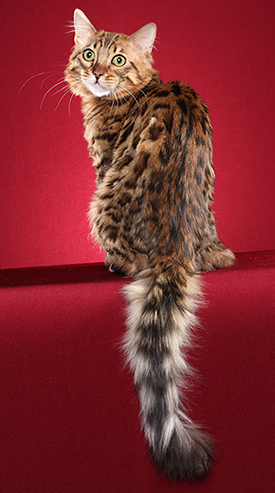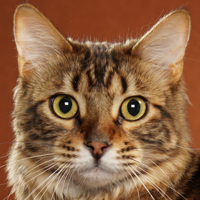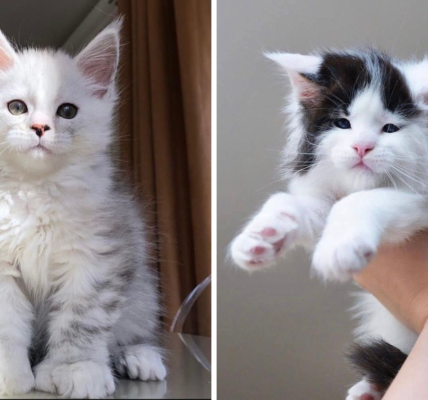Bengal Breed at A Glance

Known for their exotic looks yet attentive and loving nature, the Bengal is one of the most recognized breeds of cat. Bengals are very social and people-oriented and thrive in the company of other people. Find out more about this breed and if a Bengal is right for you and your family.
- Temperament: Active, Playful, Intelligent
- Size: Bengals reach their full size by the age of 2
Males: Approximately 9-15 pounds
Females: Approximately 6-12 pounds
Kittens: weigh about 1 pound per month, therefore a 4-month-old kitten is typically 4 pounds. - Colors: Brown Tabby, Silver Tabby, Seal Lynx Point, Seal Sepia Tabby, Seal Mink Tabby, Spotted, Marble, Charcoal Spotted or Charcoal Marble pattern.
- Life Expectancy: 12 to 20 years depending on many factors including environment and nutrition.
General Description

Loved by those who appreciate its inquisitive and loving nature, the Bengal is a medium to large cat renowned for its richly colored, highly contrasted coat of vivid spots or distinctive marbling. Originally developed from crosses between the domestic cats and the Asian Leopard Cat, the Bengal is the only domestic cat that can have rosettes, like the markings on Leopards, Jaguars and Ocelots. Today’s domestic Bengal cat comes only from breeding Bengals to other Bengals and requires no specialized care. Since their beginning in 1986, the Bengal’s regal beauty and alluring charm have quickly made it one of the most popular breeds. Employing scientific insights and a cooperative spirit, Bengal breeders continue to develop these stunning cats with careful selection for temperament, health and beauty. Bengals participate in TICA shows throughout the world and have a devoted following of happy pet owners who couldn’t imagine sharing their lives with anything other than these feline beauties.

History
Throughout history there are indications of a profound human fascination with the large and small wild felines that inhabit the jungles and forest of the world. In 1963, Jean S. Mill crossed the domestic cat with the Asian Leopard Cat, a spotted five to twelve pound shy wild cat species from Asia. This was the first effort to use hybrid offspring to create a breed of domestic cat with the loving nature of a favored fireside tabby and the striking look associated with Leopards, Ocelots and Jaguars. The modern Bengal breed traces to cats bred by Mrs. Mill beginning in the early 1980’s. The breed’s name is a reference to the scientific name of the Asian Leopard Cat, Prionailurus bengalensis. The hybrid crosses are registered as Foundation (F1, F2 & F3) Bengals that are not eligible for show and only the females are used for breeding.

Accepted as a new breed in TICA in 1986, Bengals gained championship status in 1991. Even though LH Bengals existed along with shorthair Bengals since the beginning, they were not recognized for TICA Championship status until 2017. Bengals are now one of the most frequently exhibited breeds in TICA. An enthusiastic group of breeders around the world have successfully fulfilled the goal of creating a domestic, civilized house cat that wears the richly patterned coat of the jungle cats and has some of the arresting features that have inspired and aroused humanity for centuries.
Personality

While you can train a Bengal to have “good manners”, they are an active, inquisitive cat that loves to be up high. If you don’t like a cat to leave the floor, a Bengal is probably not the right cat for you. Bengals are busy by nature. They are very affectionate and can be a “lap cat” whenever THEY want to be, but in general their idea of fun is playing, chasing, climbing and investigating. When a Bengal is in full play mode, it’s rather like trying to hold on to running water! They’ll often save the cuddle time for when they want to sleep. Many Bengals enjoy water and may join you in brushing your teeth or taking a shower. Some Bengals are vocal while others are more quiet and selective about using their voice.
Bengals will also, in general, ALWAYS want to be where you are. After all, that’s where the action is! And Bengals are all about “The Action”. When given the choice of a static toy, and one that does wild, unpredictable things, Bengals will always choose the “wild” one! For individuals or families who enjoy rambunctious, funny, beautiful and dynamic feline companionship, consider the Bengal.
Traits

The Bengal is most noted for its luxurious, soft coat which can be either short or long, and spotted or marble patterned.
The silky coat texture means that the long hair, like the short hair, is less likely to mat or tangle. A regular light brushing or combing will keep your Bengal’s coat in top condition, and the cats enjoy the extra attention.
Some Bengal’s coats feature something called glitter which imparts an iridescent sheen to each hair. The spotted pattern is most associated with the “leopard look” as the coat features clearly discernible spots and rosettes. The Bengal’s spots can be large or small and often include rosettes, like the spots of Jaguars and Leopards, which are two-toned spots. Bengals may also be marbled, which is a derivative of the classic or “bull’s eye” pattern found in many breeds of cats but with an especially dramatic appearance in Bengals. The marbled Bengal has a swirling pattern that appears as random swirls or thick diagonal and horizontal lines flowing across the coat of the cat.
The most popular color of the Bengal is the brown/black tabby, a lackluster description for coats that can be anywhere from a cool grey to vibrant shades of golden, bronze, copper or mahogany with spots or marbling ranging from rich browns to intense black. Bengals also come in a range of colors associated with a form of albinism, called “snow” by breeders, that indicates Siamese and Burmese ancestry. In these colors the coat appears ivory, cream or light tan with spots or marbling that may range from light brown to dark chocolate and the eye color is blue to aqua. Silver Bengals have grey to nearly white backgrounds with dark grey to black patterns. Also distinctive about the Bengal’s coloring is that they may have nearly white undersides and facial markings that still show the tabby pattern.
Bengals are medium to large cats, from 6-15 pounds, with males generally being larger than females. A healthy Bengal is well muscled and has an appearance that depicts its athleticism. Bengals are balanced cats and none of its physical features should appear exaggerated or especially pronounced.
Bengals are generally confident, curious and devoted companions. They get along well with other pets when properly introduced and enjoy being part of a family. Each Bengal is an individual and those interested should find out as much as they can about this wonderful breed before adding one to their family.


mohamed salah panini [url=http://mohamed-salah-az.com]mohamed-salah-az.com[/url] barcelona b mohamed salah az com .
de bruyne chelsea [url=http://kevin-de-bruyne-az.com]kevin-de-bruyne-az.com[/url] manchester united fc shop online http://kevin-de-bruyne-az.com .
mostbet uzb90 [url=http://www.mostbetlogin-kz.kz]mostebet[/url] казино онлайн на деньги mostbet com .
plinko казино [url=http://www.plinko.luchshie-casino.com/]plinko казино[/url] онлайн казино http://plinko.luchshie-casino.com/ .
Can you be more specific about the content of your article? After reading it, I still have some doubts. Hope you can help me.